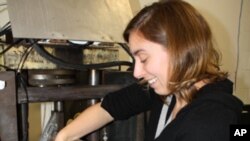Earthquakes are among the most devastating and frequent natural disasters on the planet - and also among the least understood.
Scientists at Columbia University’s Lamont-Doherty Earth Observatory, about 30 kilometers north of New York City, are working to change that.
Quake dynamics
The Rock Mechanics Laboratory is one of several specialized labs at Lamont-Doherty’s Division of Seismology, Geology and Tectonophysics, now studying the subterranean dynamics of earthquakes.
Research professor Heather Savage fires up a machine that simulates, in miniature, real earthquake conditions - the rubbing, slipping and sliding of the Earth’s massive plates, generating data for analysis.
“So what we do here in our lab is put two pieces of rock that we’re interested in, say two pieces of granite, and then we put them under stress, and then load them and load them and load them until they want to slide," Savage says. "And then we look at things like how much stress did we have to put on those rocks until they started sliding? And that tells us something about how strong that fault surface is. And that tells us something about how much stress a fault in nature can take before it starts having an earthquake.”
Significant differences
Savage acknowledges there can be significant differences between the highly controlled mini-quakes she generates in her laboratory and those that occur in nature.
“The problem comes in when you start to think of how complex fault zones really are. They are much bumpier than that, which can completely change your distribution of stress on the whole fault. And as soon as you start to slide things past each other, you start to break some of that roughness up and create little particles. And now your fault is no longer two pieces of rock touching each other. Now it’s got a layer of what we call ‘gouge’ in between, which is all those busted up particles of your original two surfaces. Now you’re talking about the strength of a granular material. And that opens up a whole new branch of physics which is also not well understood and that is the behavior of granular material. So there are lots of interesting things that go on in faults and a lot of different sciences that get pulled in.”
Many of those sciences are the focus of the other labs at Lamont-Doherty Earth Observatory. Geo-chemists, for example, analyze the temperature and molecular properties of the Earth’s material. Physicists can help answer questions about how earthquake aftershocks work.
Tremors
For example, when plates shift or bump against each other, why isn’t there one massive shudder followed by complete rest once the tension has been relieved, rather than the series of smaller, potentially dangerous tremors that follow the collision of plates?
One answer lies in the fact that the initial major quake only relieves some of the pent-up energy between two opposing plates. So called “aftershocks” just finish the job, as when a rock slides down a mountain, comes to rest, and is jolted into continuing its downhill course.
Another reason for aftershocks are the “seismic waves” that earthquakes generate, which Savage likens to what happens when you jiggle the end of a loose metal spring.
“If you just tweak that spring, just give it a little push, you can watch a wave travel from where I pushed it and it will end up at you and then a smaller wave will come back at me, and so forth, depending on how hard I pushed it.”
Much of the seismological work at Lamont-Doherty is more practical than theoretical. For example, the global network of digital seismic monitoring stations it helps to manage enables scientists and governments around the world to be alerted almost immediately when an earthquake occurs.
Because the digital information travels through cyberspace faster than seismic waves propagate through the earth, people can sometimes be warned before a quake strikes their local areas.
Scientists might never be able to predict the when and where of particular earthquakes. But Lamont Doherty seismologists are also working to develop mathematical earthquake probability models. The models could save lives by giving government leaders and urban planners a more accurate picture of the earthquake risk in any given area.










